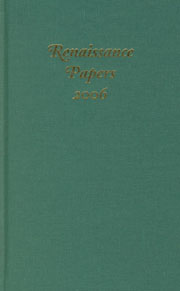Book contents
- Frontmatter
- Contents
- Renaissance Papers
- Youthes Witte: An Unstudied Elizabethan Anthology of Printed Verse and Prose Fiction
- The Power of Association: A Study in the Legitimization of Bianca Cappello through Medici Matriarchal Portraiture
- Vindicta and Vindiciae on the Early English Stage: Imagining Revenge through Huguenot Resistance Theory
- Breaking the Head of the Serpent: Women's Childbirth Prayers in The Monument of Matrones
- “Conquered nations mean nothing in love”: Political Dissent in Propertius's Elegy II.7 and Donne's “Love's Warre”
- Correcting Double Vision in The Comedy of Errors
- Lear's Awakening: Texts and Contexts
- The Power of Fantasy in Middleton's Chaste Maid: A Cost/Benefit Analysis
- Invariant Paratexts in English Dramatic Texts
- Milton and Forgiveness
- Samson at the Fair
- The End of Samson Agonistes
Correcting Double Vision in The Comedy of Errors
Published online by Cambridge University Press: 12 September 2012
- Frontmatter
- Contents
- Renaissance Papers
- Youthes Witte: An Unstudied Elizabethan Anthology of Printed Verse and Prose Fiction
- The Power of Association: A Study in the Legitimization of Bianca Cappello through Medici Matriarchal Portraiture
- Vindicta and Vindiciae on the Early English Stage: Imagining Revenge through Huguenot Resistance Theory
- Breaking the Head of the Serpent: Women's Childbirth Prayers in The Monument of Matrones
- “Conquered nations mean nothing in love”: Political Dissent in Propertius's Elegy II.7 and Donne's “Love's Warre”
- Correcting Double Vision in The Comedy of Errors
- Lear's Awakening: Texts and Contexts
- The Power of Fantasy in Middleton's Chaste Maid: A Cost/Benefit Analysis
- Invariant Paratexts in English Dramatic Texts
- Milton and Forgiveness
- Samson at the Fair
- The End of Samson Agonistes
Summary
AS the tendency to produce The Comedy of Errors with one actor playing both parts of the Antipholus Twins (and another actor for both parts of the Dromio roles) seems to be on the increase, perhaps it might be useful to examine this directional device, which invites us—as the reviewers point out—to admire the skill of the actor in distinguishing the two personalities in the two roles. I have not sought out records of directors' attempts to stage The Comedy with one actor for the two roles; no doubt it is a scheme to save a second actor's salary. It is evident, however, that the trend began sometime in the 1960's and has continued. To start at the top, we might remember that the RSC performed it that way in 1990 in Stratford. The production was amusing, but basically flawed. It was, to borrow a phrase, “solely singular for the singleness.” Dr. Robert Smallwood, reviewing the production, observed that the doubling limited “the audience's participation in the joy of recognition and reconciliation … to simple curiosity about how the trick was done.” That is not a helpful approach to this rollicking and serious play. On the other hand, the Company did it brilliantly in Tim Supple's production in 1996.
The individual twins are carefully separated by Shakespeare during the course of the play; a single actor could indeed double in the two parts of Antipholus—perhaps not of Dromio (see below)—until the end of the play when the twins are finally together on stage at the same time, “hand in hand.”
- Type
- Chapter
- Information
- Renaissance Papers 2006 , pp. 91 - 96Publisher: Boydell & BrewerPrint publication year: 2007



